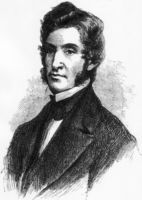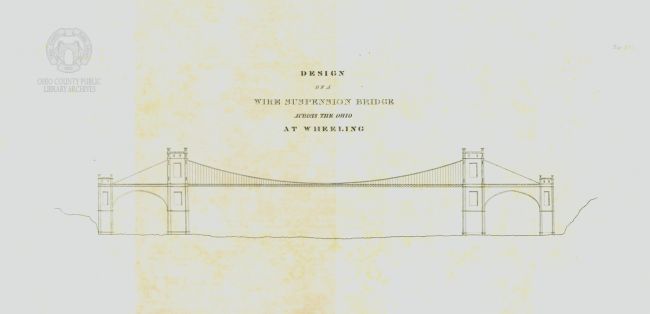
Biography: Charles Ellet, Jr.
 Civil engineer Charles Ellet, Jr. (1810-1862), bridged the Ohio River at Wheeling, Virginia with a suspended span of 1,010 feet. The bridge was then the longest single span suspension bridge in the world. The first official crossing of the Wheeling Suspension Bridge took place October 20, 1849 when Ellet drove a carriage over its entire length. On May 17, 1854, the Bridge collapsed in a windstorm. Soon rebuilt by Ellet, the bridge reopened in 1854. Ellet convinced Secretary of War, Stanton, of the feasibility of a naval Civil War, steamboat ram fleet as an “official weapon of war” for use on the Mississippi River. June 6, 1862, Colonel Charles Ellet in charge of the fleet, in the greatest naval battle of the Civil War, completely destroyed Commodore Montgomery's Confederate navy resulting in the capture of Memphis. Ellet, wounded in the battle, died June 16, 1862.
Civil engineer Charles Ellet, Jr. (1810-1862), bridged the Ohio River at Wheeling, Virginia with a suspended span of 1,010 feet. The bridge was then the longest single span suspension bridge in the world. The first official crossing of the Wheeling Suspension Bridge took place October 20, 1849 when Ellet drove a carriage over its entire length. On May 17, 1854, the Bridge collapsed in a windstorm. Soon rebuilt by Ellet, the bridge reopened in 1854. Ellet convinced Secretary of War, Stanton, of the feasibility of a naval Civil War, steamboat ram fleet as an “official weapon of war” for use on the Mississippi River. June 6, 1862, Colonel Charles Ellet in charge of the fleet, in the greatest naval battle of the Civil War, completely destroyed Commodore Montgomery's Confederate navy resulting in the capture of Memphis. Ellet, wounded in the battle, died June 16, 1862.
(John Bowman for Legendary Locals of Wheeling)

-an early Ellet design for the suspension bridge show a much more Gothic-looking structure. Image from Pamphlet "Cumberland Road East of the Ohio," Ohio County Public Library Rare Books Collection
▶ Read more about this drawing on Archiving Wheeling, our archives blog: Bridging Time — Ellet’s Gothic Looking Suspension Bridge
- biography from the National Cyclopaedia of American Biography. New York, J. J. White, 1897; v. 4.
ELLET, Charles, civil engineer, was born at Penn's Manor, Bucks co., Penn., Jan. 1, 1810, son of Charles and Mary (Israel) Ellet, and grandson of Charles and Hannah (Carpenter) Ellet. His father, a farmer, was a member of a well-known Quaker family and his mother, daughter of Israel Israel of Philadelphia was one of the most remarkable women of her time, being alluded to by a Philadelphia journal as the "American Cornelia."
The son was brought up on his father's farm and attended school at Bristol, Pa. From his earliest years he had shown an unusual talent and fondness for mathematics and at the age of sixteen had far outgrown the scope of the school's mathematical curriculum.
After a course of study at the Ecole Polytechnique, Paris, France, he secured employment on various engineering works becoming first assistant and soon afterward chief engineer of the James river and Kanawha canal. His attention at this time was devoted chiefly to the study of methods of inland communication, more particularly suspension bridges, and in 1841-42, he constructed the wire suspension bridge across the Shuylkill river at Fairmont, the first of its kind in America. He prepared plans for many other bridges including one across the Mississippi at St. Louis, one across the Connecticut at Middletown, and one across the Potomac at Georgetown. After a period as chief engineer and president of the Schuylkill Navigation Co., he designed and built the first suspension bridge across the Niagara river below the falls and what was then the longest single span bridge in the world, over the Ohio river at Wheeling.
In 1850 he was called upon by the war department to make surveys and investigation for the preparation of adequate plans for protecting the delta of the Mississippi from inundations and for increasing the depth of the water over the bars at its mouth. Having previously been engaged on the Baltimore and Ohio railroad, Mr. Ellet now became chief engineer of the Central Railroad of Virginia and in 1853 built a railroad over the Blue Ridge at Rock Fish Gap, which was probably the most remarkable line then in existence. It crossed the mountain at a height of 1,845 feet, was eight miles long, and had a maximum grading of 296 feet per mile and minimum radius of curvature of 234 feet.
In the following year he submitted to the Russian government his plan of using steamships as battering rams in time of war. The project was favorably considered, but the sudden death of Czar Nicholas put an end to the negotiations. Mr. Ellet then brought his ideas to the notice of the American government. Convinced of their value he worked with unabated energy and determination to have them tried by the government, but, owing to the lethargy which pervaded the naval department before the civil war or owing to the inability of the authorities to recognize the advantages of his scheme, the proposed rams found no favor with the government. It was not until the Confederate ram Merrimac, built according to suggestions contained in Mr. Ellet's memorial to the Virginia legislature before the war, had demonstrated the efficiency of that means of defense that the secretary of war appointed him colonel of engineers and commissioned him to buy vessels and convert them into rams.
Accordingly he purchased five heavy tow-boats, at Pittsburg and four side-wheel steamers at Cincinnati, and after strengthening them with heavy timbers and sheathing of iron-bars and bulwarks of oak, took them down the river to join Capt. Davis' squadron above Memphis. On June 6 a battle was fought, in which, Ellet in command of the Queen of the West rammed the Confederate General Lovell, cutting her nearly in tow, and causing her to sink in a few seconds. At the moment of the collision, Ellet, who was standing on deck in an exposed position, was struck in the knee by a bullet which caused his death. As he was being borne off the steamer he called to his younger brother, Alfred W. Ellet, in command of the ram Monarch, "Stand to your post."
Col. Ellet was a voluminous writer on professional subjects and a keen controversialist. He left a mass of vigorous, pointed, exhaustive pamphlets and memoirs connected with the public works under his charge, and other matters. Among the most interesting of these are "The Army of the Potomac and its Mismanagement," addressed to the president of the United States (1861); "Military Incapacity and What it Costs the Country," addressed to the congress of the United States (Feb. 1862); pamphlets on the "Location of the Baltimore and Ohio Railroad," on "Coast and Harbor Defences," and on the "Mountain Top Track"; a report to congress on the Mississippi; a memoir on the Ohio, published in the Transactions of the Smithsonian Institution; and a report on the improvement of the Great Kanawha.
Col. Ellet was married about 1840 to Elvira Augusta Stuart, daughter of Judge William Daniel of Lynchburg, Va., who died of grief eight days after his death. They had four children: Mary Virginia, Charles Rivers, Cornelia Daniel, and William Ellet. Col. Ellet died at Cairo, Ill., June 21, 1862.
Wheeling Suspension Bridge | Biographies | Wheeling History Home | OCPL Home









 Want to keep up with all the latest Library news and events?
Want to keep up with all the latest Library news and events?